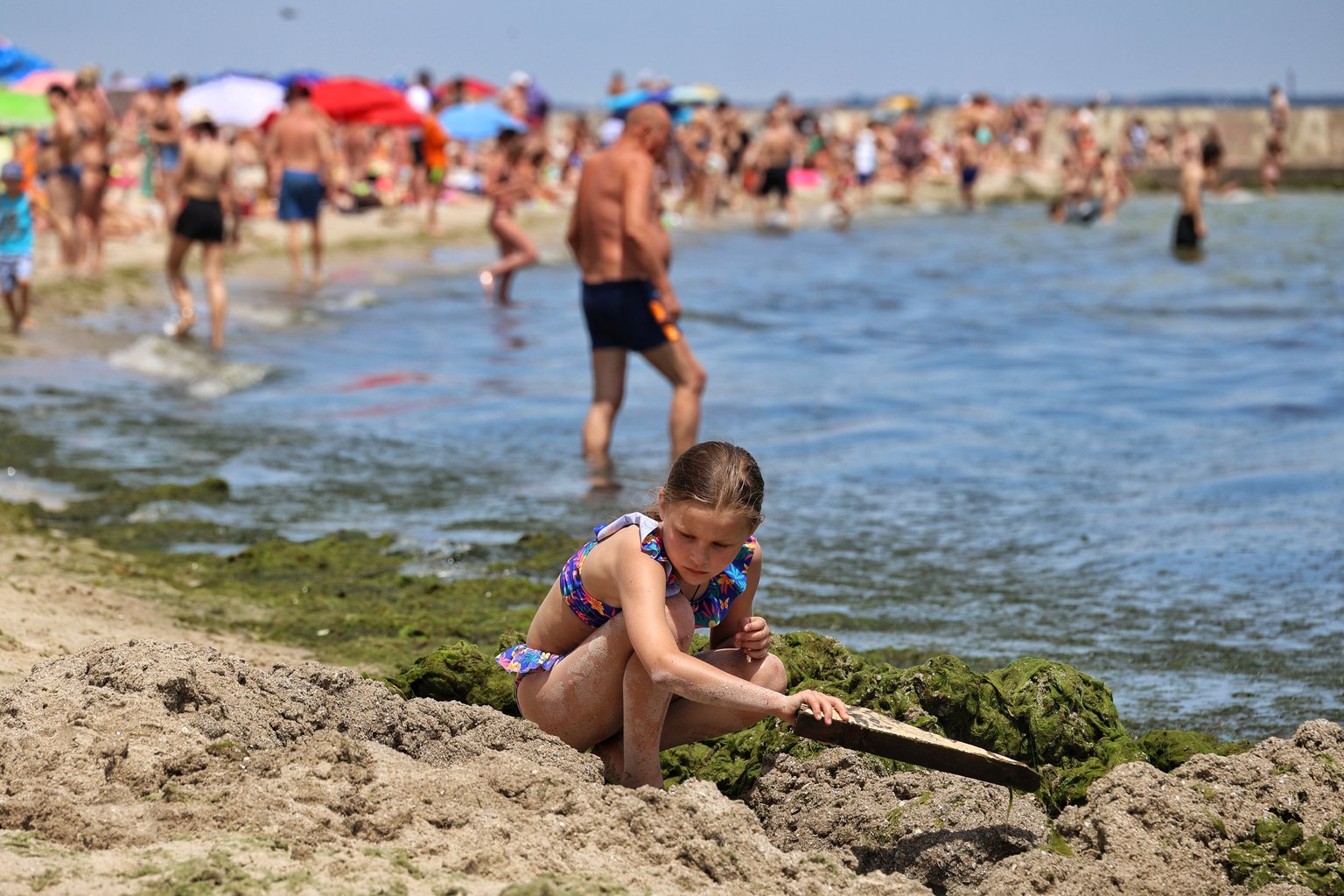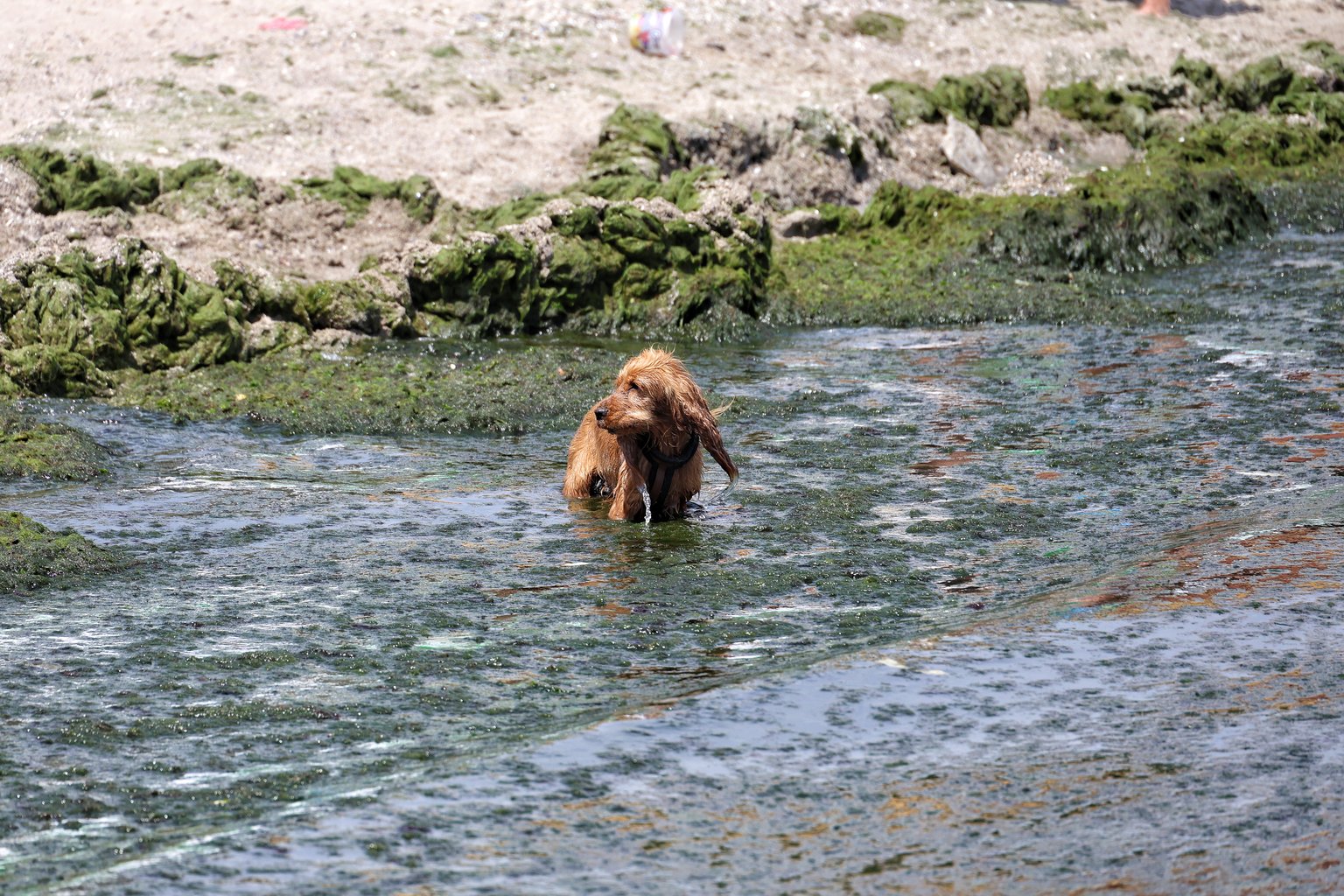On a hot summer morning, the locals of war-torn Odesa, tired from the heat, air raid alerts, and the constant talk of violence and the military draft, rush to the happiest place they know: the beach. Music plays at the Nemo dolphinarium on Lanzheron Beach, a traditional hangout spot for Ukrainian youth to date, lie on the hot sand, breathe in the salty air, and watch the waves.
The beach is crowded for a Thursday morning. Young women in swimsuits line for coffee at a kiosk; a mother and a daughter wrestle with a cigarette lighter in the wind; a young family arrives with a baby in a stroller and a huge, inflatable crocodile. As they approach the water, the family stops and hesitates: something is wrong with the sea. It is not blue, but dark green.
Seaweed is everywhere. In the water, on the sand, on the concrete blocks along the coast, all over swimmers. I grew up on the Black Sea. I know its smell and taste well, and both were different on Lanzheron Beach that morning.
City authorities opened the beach season on 6 June, the day of the first anniversary of the explosion of the Kakhovka dam on the Dnipro River, which resulted in the draining of what had been the second-largest reservoir by surface area in Europe.
The catastrophe ruined lives in several Ukrainian cities and polluted the sea with landmines washed from military positions, toxic chemicals, and fertiliser runoff. Odesa’s seashore turned into a literal minefield. Beachgoers fished out furniture, forest debris, and dead animals brought to the city by the current after the disaster.
Yelena Pogribniak, the mother of 9-month-old Maksim, the boy in the wagon, leans against a metal fence on the embankment and closes her eyes. She is exhausted. “This used to be our most romantic place, but even here, we cannot forget about the war,” she said. “You cannot take your mind away, not when you have a baby, when you have a young husband who can go away to the front any day. There are reminders of the war everywhere. Even this epidemic of the seaweed is a reminder.”
The seaweed that invades Odesa’s favourite beach is called Zostera marina, a kind of seaweed macroalgae known as eelgrass, and its wild performance this month is an unhealthy sign. On the day the beach reopened, the sad anniversary of the dam catastrophe, there was an international scientific conference devoted to the ecological issues of the Black Sea. Ukrainian and international scientists, environmentalists, and ecologists discussed the results of tests and the growing evidence of the disastrous pollution and desalination of the seawater in the Black Sea, which has little circulation with the open ocean.
The conference took place online. “Zostera covering the water and the shore is an alarming sign of the Black Sea desalination in Odesa,” was the conclusion of the conference, according to Igor Katovsky, docent at the Botanic and Geography faculty at Kherson University.
“The research on water salinity in the northern Black Sea conducted by several scientific institutions has shown that if before the war, the water in Odesa and Kherson regions had a ratio of 18 milligrams of salt per litre, now it measures between 12 and 16 milligrams,” he told The Black Sea.
The Kakhovka dam was visibly damaged by fighting even before the explosion on 6 June 2023, which occurred the day after Ukraine began a counteroffensive to recapture southern territory.
There is well-reported evidence that a Russian missile destroyed the dam in an attempt to thwart a Ukrainian cross-river assault by flooding the area downstream, but Russia denies this.
The torrent of freshwater flooded 620 square kilometres of Ukrainian territory, according to a United Nations report. Silt laden with fertiliser flowed to the sea. “The water that reached the north-western part of the Black Sea shore contained a huge amount of phosphorus, potassium and sulphur. According to this year’s tests, the water still contains an alarming amount of toxic chemicals that are destructive to the environment,” Katovsky said.
Last year, the sea brought the evidence of the disaster to the doorstep of the Nemo Hotel and dolphinarium, the heart of the Lanzheron beach.
“It was a very sad scene: parts of furniture were floating in the sea, even a fridge was in the water – I have no idea how it could float,” Marina Gubanova, the hotel manager, told The Black Sea in an interview on Thursday. “Water was full of garbage, big and dirty garbage, the sea was an ugly colour, a mix of brown and grey. We tried not to approach the sea.”
The flooding caused by the catastrophe had long-term effects. It damaged the stable environment on the banks of the Dnipro River and local lagoons and small river mouths; the water smelled of petroleum. Locals are still careful with fish. But there is one place near the beach that cooks healthy meals of locally produced foods for up to 1,000 visitors a day: the relaxing and homey Dacha restaurant. “A lot of fish was either poisoned with toxins or left the shore for deeper water, the Kakhovka catastrophe changed our menu.”
Odesa’s celebrated restaurant developer and chef, Savva Lipkin, told me that the restaurant has since switched to freshwater fish. “Our local fishermen are banned from sailing, they still fish from shore but we prefer to buy fish from rivers and lakes, where we know the water is clean.”
Ukrainian and national researchers have been documenting the damage to the Black Sea shore for a year. The environment has no borders. The Black Sea’s water is shared by Bulgaria, Romania, Georgia, Turkey, Ukraine, and Russia and when one country destroys a common sea, the world pays attention.
Katovsky participated in the conference together with colleagues from Lithuania, Poland, Bulgaria, and Germany, to research the damage to the ecology in Ukraine’s regions. Unfortunately, the Black Sea continues to suffer, while thousands of missiles rain across Ukraine’s southern regions. The war is an endless catastrophe for Odesa: about 100 civilians have been killed, hundreds wounded, and the city’s graceful architecture - museums, schools, churches - destroyed by Russian missiles.
Back on Lanzheron Beach, kids grab heaps of soggy plants and throw them at one another. One girl covers her body with a green blanket of seaweed. “Soup, soup, the sea cooked us some soup!” she told her girlfriend.
Pogdibniak touches the soft green mess with her foot with undisguised disgust. “The sea is like some thick borsch soup now, indeed, and it is not as salty as it used to be. I don’t like it,” she said. “This must be the consequences of last year’s catastrophe.”
Olga and Valeria Yegoshin, the mother and daughter, finish smoking, grab each other’s hands and walk down the slippery steps of a concrete stairway into the water. Olga, too, is exhausted from stress. Her legs hurt, and she is limping. Even a few minutes in the seawater helps ease her pain and she begins to walk better and feel stronger.
We speak again on Monday. A Russian missile had hit one of the major food storages in Odesa and the sky over Odesa was black for several hours. She said there was no longer any place for romance on the shore, even on the most romantic Lanzheron Beach. But if you close your eyes, the sea still heals, even being sick itself, she said. “When they bomb us, I go to the beach to at least put my feet in the water – the sea helps us feel alive.
Opening image by Nina Lyashonok

